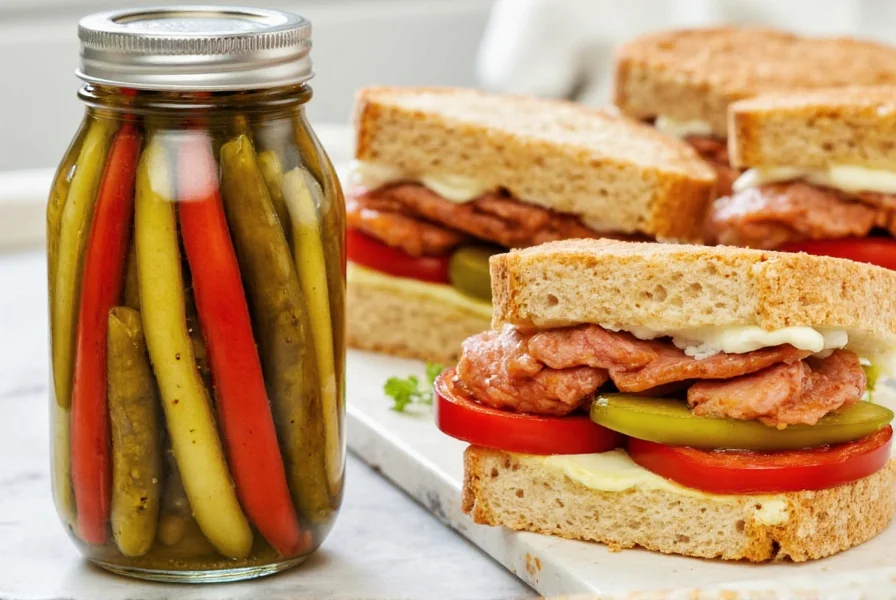If you're searching for the best way to store pickled Italian veggies to keep them fresh and flavorful, you've come to the right place. Proper storage is critical for maintaining texture, flavor, and safety—especially since these YMYL (Your Money or Your Life) food items require accurate, trustworthy information.
| Storage Method | Shelf Life | Key Guidelines |
|---|---|---|
| Unopened jar at room temperature | 6–12 months | Store in a cool, dark place away from direct sunlight. Always check the expiration date on the label. |
| Opened jar in refrigerator | 4–6 months | Keep veggies fully submerged in brine. Use clean utensils to avoid contamination. Seal tightly after each use. |
| Freezer (brine only) | Up to 3 months | Freezing whole veggies is not recommended. Use airtight containers for brine only to prevent freezer burn. |
| Homemade refrigerated | 2–3 weeks | Ensure proper sterilization of jars and brine. Consume within this timeframe for optimal freshness and safety. |
Why Proper Storage Matters for Food Safety
Pickled Italian veggies are considered YMYL content because improper storage can lead to foodborne illnesses. The acidic brine preserves the vegetables, but exposure to air, heat, or contaminants can compromise safety. Always follow these CDC-recommended guidelines:
- Never store opened jars at room temperature
- Avoid cross-contamination by using clean utensils
- Discard if you see mold, cloudiness, or off-odors
How to Maximize Shelf Life
These evidence-based techniques will keep your giardiniera crisp and safe:
- Submerge completely: Always ensure vegetables are fully covered by brine. If brine level drops, add a mixture of 1 part vinegar to 1 part water to maintain acidity.
- Use glass containers: Glass jars prevent chemical leaching better than plastic. For homemade versions, sterilize jars by boiling for 10 minutes before filling.
- Refrigerate immediately after opening: Never leave opened jars at room temperature for more than 2 hours.
- Check for spoilage signs: Discard if you notice bubbling, sliminess, or unusual smells—these indicate bacterial growth.
Common Storage Mistakes to Avoid
| Mistake | Risk | Correct Practice |
|---|---|---|
| Storing in metal containers | Chemical reactions with acidic brine | Use only glass or food-grade plastic containers |
| Leaving jar lid loose | Oxygen exposure leading to spoilage | Seal tightly with airtight lid after each use |
| Using dirty utensils | Bacterial contamination | Always use clean, dry utensils when handling |
| Freezing whole veggies | Texture destruction and potential safety issues | Only freeze brine separately in small portions |
Expert Recommendations from Food Safety Authorities
The USDA and FDA recommend these practices for all pickled vegetable products:
- Temperature control: Refrigerate at 40°F (4°C) or below
- Shelf life verification: When in doubt, throw it out—don't risk food poisoning
- Labeling: Always note the opening date on homemade jars
For commercial products, follow the manufacturer's storage instructions. If no date is provided, assume a 6-month shelf life for unopened jars and 3 months for opened jars when refrigerated.
FAQ: Pickled Italian Veggies Storage
Can I reuse the brine from pickled veggies?
Yes, but only for non-YMYL purposes like marinades or dressings. Never reuse brine for new pickling projects due to potential bacterial contamination. Strain and refrigerate for up to 2 weeks for non-food safety-critical uses.
What should I do if my veggies turn mushy?
Mushiness indicates texture degradation but doesn't necessarily mean unsafe. They're still edible for cooked dishes like stews or sauces, but should not be eaten raw. Always check for other spoilage signs before consuming.
How do I know if my pickled veggies have gone bad?
Look for these critical signs: mold growth, cloudy brine, bubbling, off-odors (like rotten eggs), or slimy texture. If any of these are present, discard immediately—do not taste test.
Can I store pickled Italian veggies in the freezer?
Only the brine can be frozen (in small portions for up to 3 months). Freezing whole veggies destroys texture and may create safety risks. Always thaw frozen brine in the refrigerator before use.
Is it safe to store pickled veggies in plastic containers?
Only food-grade plastic containers labeled "BPA-free" and "acid-safe" are acceptable. Glass is always the safest option for long-term storage of acidic foods. Never use recycled plastic containers.
Conclusion: Safe Storage Practices for Food Safety
Proper storage of pickled Italian veggies isn't just about flavor—it's a critical food safety practice. By following USDA and FDA guidelines, using the right containers, and monitoring for spoilage signs, you can enjoy these flavorful ingredients safely for months. Remember: when it comes to YMYL food content, accuracy and safety must come first.











 浙公网安备
33010002000092号
浙公网安备
33010002000092号 浙B2-20120091-4
浙B2-20120091-4